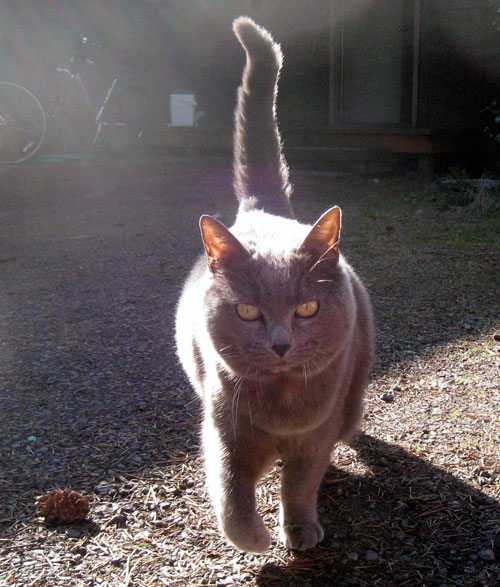Archive ∙ Back to Island Voices
June 2014
Cats hide their emotions well and we are often surprised by how they react to things. This is because we are not reading their body language very well. By body language, I’m talking about their tail carriage, ear position, where their paws are, and their body posture, combined with vocalizations and movements.
If you can pick up on these signs of communication, you can determine what cats are trying to say to you. This isn’t a skill you can learn by reading about it (like here). You have to watch cats, all kinds of cats, in all kinds of situations. Once you can appreciate their signals, you’ll react the right way, and cats will learn to trust you. You’ll also avoid misunderstandings and the aggression that can come along with it.
When assessing body language, you have to look at the whole package to be able to interpret the message, but we’ll begin by looking at the individual parts separately for better understanding.
Let’s start with the ears. The ears are directed by over 20 muscles which enable them to move to almost any position. They aren’t just for hearing – they send out vital messages to other cats (and you).
A relaxed cat’s ears point a little to the side and a little forward. This contented cat is neither fearful nor aggressive. An alert cat shows interest by pointing her ears forward and they are pricked (straight up). We see this posture when cats come to greet us.
In contrast, a nervous cat is on guard and you’ll see the ears twitching because the cat is aroused. In some circumstances, you could reassure this cat to reduce nervousness.
When we look at an aggressive cat, the ears tell us a different story. When the ears move from pointing forward to pointing backward, a fight could be on. Ears that more from upright to full horizontal (what some people call airplane ears) can indicate fear, annoyance, or submissiveness. This is a warning to leave the cat alone.
If ears flatten against the head, this is a defensive posture and you have a frightened cat that may attack. We think the ears are flat so that they are harder to hit in a fight. This cat should not be touched or picked up. You could be risking injury, one severe enough to send you to hospital.
Sometimes we see ears that go in different directions. This is a cat that can’t commit and it’s unsure of how to respond. These cats would prefer to withdraw so they can assess the situation.
The next part of the cat to watch is the tail. If we see the tail swishing from side to side, she is prompting her prey to make a move so that she can plan her attack. In this “whip” mode, it’s not a good idea to give her a target. Rather than offering a hand as an attack item, throw her a toy to attack.
Another dangerous tail position is the “hook”. The tail is down on the ground but the tip is up like a hook. This cat is unsure of the situation and a little nervous. She is also defensive so she could attack if enticed.
If the tail is fluffed and looks like a bottlebrush, it tells is that the cat feels threatened. If this is combined with an arched back and hair on end, we have the classic Halloween cat.
In contrast, if a cat holds the tail straight up, and especially if it is quivering, she’s happy to see you. Give her all the attention she is craving.
This excerpt is from an upcoming book on feline behaviour, written by Dr. Jeff. Enjoy!



Leave a Reply